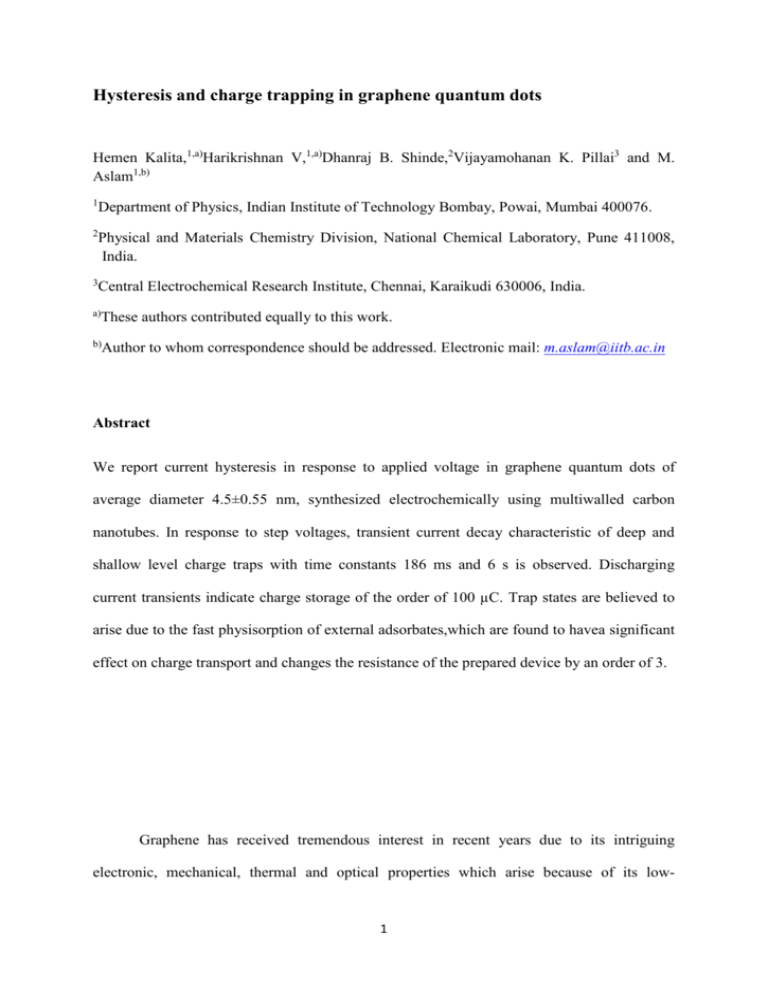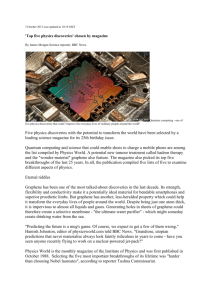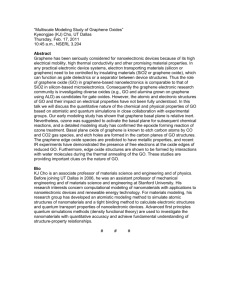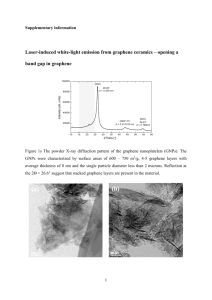quantum diameter
advertisement

Hysteresis and charge trapping in graphene quantum dots Hemen Kalita,1,a)Harikrishnan V,1,a)Dhanraj B. Shinde,2Vijayamohanan K. Pillai3 and M. Aslam1,b) 1 Department of Physics, Indian Institute of Technology Bombay, Powai, Mumbai 400076. 2 Physical and Materials Chemistry Division, National Chemical Laboratory, Pune 411008, India. 3 Central Electrochemical Research Institute, Chennai, Karaikudi 630006, India. a) These authors contributed equally to this work. b) Author to whom correspondence should be addressed. Electronic mail: m.aslam@iitb.ac.in Abstract We report current hysteresis in response to applied voltage in graphene quantum dots of average diameter 4.5±0.55 nm, synthesized electrochemically using multiwalled carbon nanotubes. In response to step voltages, transient current decay characteristic of deep and shallow level charge traps with time constants 186 ms and 6 s is observed. Discharging current transients indicate charge storage of the order of 100 µC. Trap states are believed to arise due to the fast physisorption of external adsorbates,which are found to havea significant effect on charge transport and changes the resistance of the prepared device by an order of 3. Graphene has received tremendous interest in recent years due to its intriguing electronic, mechanical, thermal and optical properties which arise because of its low- 1 dimensionality and linear band dispersion.1-3Although graphene based devices have shown excellent promise in various applications like field effect devices,4 memory systems,5energy storage,6 transparent conducting electrodes,7 high strength polymer nanocomposites8 etc.,significant hurdles persist that deter their utilisation for commercial and industrial usage. Accurate control over thickness, lateral size and doping is one such challenge.9The atomic level thickness and large surface area to volume ratio causes graphene devices to be extremely sensitive to external adsorbates. The geometry and nature of graphene surface plays a very important role in determining its electronic properties, a behaviour which has been utilized to create ultrasensitive gas and chemical sensors.10-11Moreover, despite its high intrinsic carrier mobility,the zero bandgapsemi-metallic nature of graphene inhibits its usagefordesigning logic devices that could serve as a superior alternative to present CMOS technology.12 The introduction of a bandgap in graphene by constraining graphene edges along one (graphene nanoribbons) or both dimensions (graphene quantum dots) is seen as a way to obviate this problem. However, the synthesis of graphene nanoribbons of accurate width and well defined edgesstill poses a significantchallenge.13On the other hand, many recent chemical synthesis of monodispersed, stable graphene quantum dots (GQDs) of size< 10 nm have been reported.14-18A greater proportion of edge states and quantum confinement in graphene leads to very high sensitivity and unique electronic properties. GQDs offer a size tunablebandgap, wavelength dependent photoluminescence and higher coulombicinteraction between charge carriers leading to size dependent excitonic levels.19For designing novel electronic and optical devices based on GQDs, a thorough understanding of their electron transport properties is essential. In this study we report hysteresisin current in GQDs in response to an applied voltage. Charging and discharging current transients are obtained in response to step voltages, which 2 indicate shallow and deep level charge trapping with time constants 186 ms and 6 s. Resistive switching and charge storage is observed, which is believed to arise due to presence of external adsorbates on the quantum dot surface. These adsorbates are also found to change conductance of the prepared devices by an order of 3 by modifying the coupling strength among quantum dots. The graphene quantum dots used for our study are synthesized electrochemically using the method recently reported by Dhanrajet al.18The prepared dots aremonodispersedand their average diameter is found to be 4.5 ± 0.55nm using transmission electron microscopy (Fig 1(a)). Fig 1(b) shows the height distribution of the prepared quantum dotstaken using an atomic force microscope. The height of the prepared dots is observed to be lesser than 2 nm, which is consistentwith one to three layers of graphene.14Fig. 1(c) shows the Raman spectrum of the as prepared dots and multi-walled carbon nanotubes (MWCNTs)with a crystalline G band at 1590 cm-1anda defectD band at 1329 cm-1. The intensity of the D peak is more in case of GQDs as compared to MWCNT indicating decrease in the size of thesp2 domains of GQDand also confirms the good quality of the precursor MWCNT.18Current-voltage measurements are carried out on a device consisting of a glass substrate on whichgold electrodes 150 nm thick were fabricated using thermal deposition, with a 50 nm chromium layer acting as buffer.Graphene quantum dots are then subsequently dropcastedonto a 1 mm wide channel in between the electrodes. Two probe measurements were carried out using a Keithley 2602Asourcemeter at room temperature in ambient environmentwith a scan rate of 500 mV/s, unless otherwise stated. The current measured as a function of voltage that is swept from -5V to 5 V and backis shown in Figure 2. A non-linear response with significant hysteresis is obtained.All the measurements yield significant current at zero voltage and show a characteristic resistive switching. For both positive and negative voltage bias, the current recorded when voltage is 3 lowered fromitsmaximum value isalways found to be lower than that measured when voltage is increased.Voltage and current displacements of 2.38 V and 11 µA about origin are recorded. The graphene quantum dot samples prepared are stable for a period of at least six months, and showed negligible (<5%) depreciation of resistance.The hysteresis curves obtained are also found to be stable after repeated measurement cycles, as shown in the inset of Figure 2. Figure 3(a) shows the transient current behaviour recorded in response to a step voltage of 5 V. The current decays with time and attains a stable value in less than a minute. The observedbehavior is consistent with charge injection into the quantum dot array and subsequent filling of associated charge trap sites present.The current decay can be excellently , where τ1 and τ2are the fit with the biexponential equation, relaxation time coefficients corresponding to two different trapping mechanisms. In the present case, the current was found to decay from 40 µA to a stable value of 12µA, withtime constants of 186 ms and 6s. The two different trapping time constants obtained can be considered to be associated with shallow and deep level traps.Trapping time constants in the range ofmilliseconds to a few seconds indicates that the trapping process in the quantum dot array is relatively fast23-25. This is further supported by Fig 3(b) which shows the effect of different voltage sweeping rates on hysteresis. Hysteresis is found to increase with increasing sweeping rate,indicating the involvement of fast charge traps that are capable of charging and discharging within a few seconds. However, it is not understood how increasing the scan rate leads to decreasing resistance. Figure 4(a) shows the current transient measuredafter removal of a constant bias voltage of 5 V. A negative current is obtained which slowly decays to zero. Similarly, a positive current is obtained upon the removal of a negative step voltage. This discharging 4 current transient obtained confirms charge injection and storage in trap sites present. Figure 4(b) shows the current recorded with different range of voltage sweeps. Increasing the voltage range is found to increase the carrier trapping. This is further supported by the data presented in Table I which tabulates the net detrapped charge (Qd)calculated from the current decay (Fig 4(a)) that results upon the removal of different step voltages. Table I also showsthe remnant current obtained during voltage sweeps of increasing scan range at a fixed scan rate of 500mV/s. Both net charge stored and the remnant current are found to increase with increase in voltage scan range.The increased charge injection observed indicates the involvement of higher trap state density with scaling of applied electric field. Previous reports attribute the hysteresis in graphene devices to charge injection at the graphene substrate interface or to the charge transfer from/to adsorbate molecules present.20 However,compared to hysteresis observed in graphene FETs, where hysteresis is seen in response to the gate voltage through the interaction of the dielectric oxide layer and gate electrode,charge injection occurring at the graphene-substrate interface in our case is not possible. To investigate the effect of surface adsorbateson the origin of hysteresis, the prepared devices are annealed at 3000C for three hours in Ar atmosphere to remove all adsorbates and contaminants present.21Immediately post annealing, when current is measured as a function of voltage, a linear response is obtained without any noticeable hysteresis (Fig 5(a)). Moreover, the resistance of the sample is found to increase by a factor of eight hundredthus yielding significant lower current in nanoampere range. A similar linear response showing current in nanoAmpere range with no hysteresis is obtained when I-V measurements are carried out in vacuum. When the sample is reintroduced into the ambient atmosphere, the resistance sharply decreases (Fig 5(b)) and graduallysettlesto a stable valuewithin few minutes (Fig 5(c)). Interestingly, non-linearity and hysteresis in current response reappear with decrease in resistance. This behaviour is found to be reproducible 5 after multiple annealing cycles.From theseobservations, we caninfer that the enhanced conductivity and charge trapping in graphene quantum dots under an ambient environment may bedue to the reversible physisorption of adsorbates. Yang and Murali22 have studied the binding mechanism of oxygen molecules and moisture on graphene and reported a sharp increase in the mobility of graphene when exposed to ambience.Theyattributed this effect to the adsorption of moisture to graphene edges and the surrounding SiO2 substrate. Schedinetal.11have also reported on the reversible adsorption of water, which decreases the resistance of graphene.11When I-V measurements were carried out in an oxygen or nitrogen atmosphere, a response similar to that shown in Figure 5(a) is obtained. However, when measurements were carried out with controlled relative humidity (RH) levels, graphene quantum dots showed progressive increase in conductance and hysteresis with increasing humidity levels. Furthermore, the transient current decay shown in Figiure 3 showed a faster decay with lower time constants upon increasing humidity levels. This clearly suggests that the adsorption of ambientwater moleculesinduces charge trapping accompanied with an increase in conductance.Graphene quantum dots, due to their spherical shape, offer a greater proportion of edge sites as compared to graphene, which could lead to increased adsorption of water molecules. The sharp increase in resistance observed when the sample is annealed can be attributed to thedesorption of adsorbedwater molecules. Graphene quantum dots when kept in ambient surroundings can readily adsorb water molecules to form a moisture layer between dots. When annealed, thedesorption of suchwater layers,leads to increased spacing and a weaker coupling among individual dots. This results in a higher potential barrier for tunnelling of electrons resulting in a higher interdot tunnelling resistance. This manifests as the drastic increase in resistance observed immediately after annealing. This 6 The mechanism by which adsorbed water moleculesgive rise to charge traps and nonlinearhysteretic current response is still unclear at the moment. The hysteretic behaviour of obtaining a lower current while lowering voltage to zero may occur due to the coulombic repulsion offered to the incoming electrons by trapped charges.We speculate that the adsorbed water molecules, with their large dipole moment will respond quickly to the applied field along the channel and the alignment of these dipoles may induce varying carrier trap density. These aligned water molecules and charges stored in trap centers will give rise to a field of their own, opposing the applied field. The discharging current shown in Fig 4(a), obtained during the detrappingof electrons after removal of an applied step voltage, can be seen as originating due to this residual electric field. The detrapping occurring when channel voltage approaches zero is responsible for yielding a significant current at zero voltage (Fig 2). The exact origin of deep and shallow natured traps and theirenergy distribution along the conduction and valence bandrequires further investigation. In conclusion, graphene quantum dots synthesized electrochemically were found to show hysteresis current in response to an applied voltage. Hysteresis has beenattributed to the presence of charge traps across the channel, which is believed to arise due to the adsorbates present on the quantum dot surface. Our work demonstrates the high sensitivity of graphene quantum dots and their electrical behaviour to the external environment. Moreover, if the charge storage mechanism is properly understood and utilized, graphene quantum dots will prove beneficial in novel designing of devices such as gas sensors, high density memory components, or materials for ultrafast charge storage. Acknowledgements: The authors would like to thank the Centre for Excellence inNanoelectronics (CEN), Central Scanning Probe Microscope (SPM) facility and Centre for Research in Nanotechnology and 7 Science (CRNTS), IIT Bombay. The Keithley 2602Asourcemeter was brought through the generous support from CSIR and IRCC funded seed grant. References: 1 A. K. Geim and K. S. Novoselov, Nature Mater. 6, 183 (2007). 2 K. I. Bolotin, K. J. Sikes, Z. Jiang, M. Klima, G. Fudenberg, J. Hone, P.Kim, and H. L. Stormer,Solid State Commun.146, 351 (2008). 3 R. R. Nair, P. Blake, A. N. Grigorenko, K. S. Novoselov,T. J. Booth, T. Stauber, N. M. R. Peres,andA.K.Geim, Science 320, 1308 (2008). 4 B. N. Szafranek, D. Schall, M. Otto, D. Neumaier, and H. Kurz, Nano Lett.11, 2640 (2011). 5 A.J. Hong, E.B. Song, H.S. Yu, M.J. Allen, J. Kim, J.D. Fowler, J.K. Wassei, Y. Park, Y. Wang, J. Zou, R.B. Kaner, B.H. Weiller, and K.L. Wang, ACS Nano 5, 7812 (2011). 6 M.D. Stoller, S. Park, Y. Zhu, J.An, and R.S. Ruoff, Nano Lett.8, 3498 (2008). 7 X. Li, Y. Zhu, W. Cai, M.Borysiak, B. Han, D. Chen, R.D. Piner, L. Colombo, and R.S.Ruoff, Nano Lett. 9, 4359 (2009). 8 T. Ramanathan, A. A. Abdala, S. Stankovich, D. A. Dikin, M.Herrera-Alonso, R. D.Piner, D. H. Adamson, H. C. Schniepp, X. Chen, R. S. Ruoff , S. T. Nguyen, I. A. Aksay, R. K. Prud’Hommeand, L. C. Brinson, Nat. Nanotechnol. 3, 327 (2008). 9 P.Avouris, Nano Lett.10, 4285 (2010). 10 J.D. Fowler, M.J. Allen, V.C. Tung, Y. Yang, R.B.Kaner, and B.H.Weiller, ACS Nano 3, 301(2009). 11 F. Schedin, A.K.Geim, S.V.Morozov, E.W. Hill, P. Blake, M.I.Katsnelson, and K. S. Novoselov.Nat Mater 6,652 (2007). 8 12 B. N. Szafranek,D. Schall, M. Otto, D. Neumaier, and H. Kurz, ApplPhysLett96, 112103 (2010). 13 F. Schwierz, Nat.Nanotechnol.5, 487 (2010). 14 D. Pan, J. Zhang, Z. Li, and M. Wu, Adv. Mater 22, 734 (2010). 15 J. Shen, Y. Zhu, X. Yang, J. Zhong, J. Zhang, and C. Li, New. J. Chem.36, 97 (2012). 16 J.Peng,W.Gao,B.K.Gupta,Z. Liu, R. Romero-Aburto,L. Ge,L. Song, L.B. Alemany, X.Zhan,G. Gao,S.A. Vithayathil,B.A.Kaipparettu,A.A. Marti,T. Hayashi, J.Zhu,and P.M. Ajayan, Nano Lett. 12, 844 (2012). 17 X.Jia , J. Li and E. Wang, Nanoscale4, 5572 (2012). 18 D.B.Shinde, and V.K. Pillai, Chem. Eur. J.18,12522 (2012). 19 L. Li, and X. Yan, J. Phys. Chem. Lett1,2572 (2010). 20 H. Wang, Y. Wu, C. Cong, J. Shang, and T. Yu, ACS Nano 4, 7221 (2010). 21 T. Lohmann, K.V. Klitzing, and J.H.Smet, Nano Lett.9, 1973 (2009). 22 Y. Yang, and R. Murali, Appl.Phys.Lett.98, 093116 (2011). 23 J. Maeng, W. Park, M. Choe, G. Jo, Y.H. Kahng andT. Lee,Appl. Phys. Lett.95, 123101 (2009). 24 Y.G. Lee, C. G. Kang, U. J Jung, J. J. Kim, H. J. Hwang, H. J. Chung, S. Seo, R. Choi and B.H. Lee, Appl. Phys. Lett. 98, 183508 (2011). 25 D.J. Late, B. Liu, H.S.S.R Matte, V.P. Dravid and C.N.R. Rao, ACS Nano.6, 5635 (2012). 9 List of Tables Table I. Net charge-dischargedof GQD assembly after applying a constant voltage bias for 10 sec and the current remanence at zero voltage obtained at different voltage scan range. Applied voltage (V) 1 3 5 7 Detrapped charge Qd(µC) 12.72 60.54 102.12 147.11 10 Current remanence(µA) 2.46 8.13 11.34 12.86 Figures FIG.1.(a) TEM images of as-prepared graphene quantum dots (GQDs).The inset shows the size distribution of GQDs. Average diameter of the dots is calculated to be 4.5 ± 0.55 nm.(b) AFM image of the dots deposited on a Si/SiO2substrate and its corresponding sectional analysis showing average height of the dots to be 2-3 nm. (c)Comparison of the Raman spectra of as-prepared GQDs and MWCNTsthat are used for preparing graphene quantum dots. FIG.2.Current recorded as a function of voltage that was swept cyclically from -5 V to 5 V. The inset shows a schematic diagram of the device structure.Inset: Hysteresis loop recorded for 20 measurement cycles. 11 FIG.3. (a)Current measured in response to a step voltage of 5 V. A fast decay of current is observed which quickly attains a stable value within a few seconds. This decay data can be modelled accurately using a biexponential decay equation with time constants 186.5 ± 2.7 msand 6.08 ± 0.04 ms.(b) I-V measurements at various voltage scan rates. FIG.4. (a) Current transient obtained after a bias voltage of 5V is applied for 10 s and subsequently removed.(b) Current measured with increasing voltage range measured at a fixed scan rate of 250mV/s. 12 FIG.5.Evolution of device conductance as a function of time post annealing at 300 0C in anAr atmosphere. Current is recorded as a function of voltage (a) immediately after annealing and (b) 2 minutes after re-exposure to ambient atmosphere (c) 10 minutes after re-exposure to ambient atmosphere. 13






